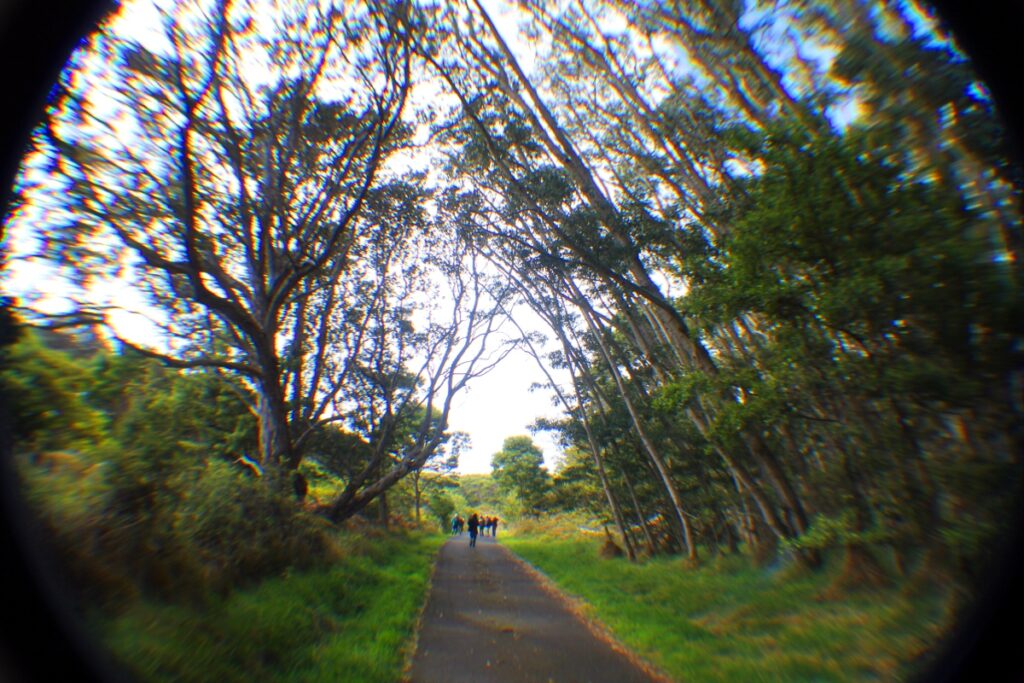
Mauna Loa is the largest volcano as well as the most voluminous mountain on planet earth. Rising more than 33,000 feet from the sea floor, it’s been erupting for 700,000 years.
Today the vast majority of this mountain remains inaccessible, but there are a few roads that lead up its massive face. Mauna Loa Road in Hawaii Volcanoes National Park is one of them. This scenic drive snakes 12 miles up the eastern face of Mauna Loa and passes through a variety of environments. The road terminates at the Mauna Loa trailhead where those few that plan ahead can continue on a four day, 60 mile hike to the top of the mountain and back. The less adventurous will enjoy a fantastic view on a clear day that includes most of the eastern side of the island and Kilauea Volcano.
The road begins on the edge of the Ka’u desert. Sparse, dry landscape with little plant life quckly changes as you drive into Kipuka Puaulu, a lush, green kipuka (a forest island spared by the lava) teeming with plant and bird life. This area is also known as Bird Park and hosts several scenic hikes. There are tree molds nearby as well where trees that were too wet to burn left deep holes in the rock where molten lava flowed around them.
Beyond the Kipuka the road is one lane and will sometimes be closed due to construction or fire hazard.
You drive over a lava flow and then enter a deep green forest. This is the ancient Koa and Ohia forest from which the ancient Hawaiians took the wood to build their canoes and the birds for their food, clothing, and ornaments. This is an old growth forest. Many of the Ohia trees here are more than a thousand years old. The Koa trees are younger, but not by much. Many are hundreds of years old. Most of these trees were here before foreigners first arrived in Hawaii. There are great widswept areas along the mountainside where 60 foot trees all lean in one direction and tunnel-like segments where the canopy forms a dense ceiling above the road, blocking out the sun. As you rise along the switchbacks every so often the trees subside and you catch a glimpse of the ocean and the island around you. This is a place where the vastness of the island becomes readily apparent.
After miles through the forest you break out into a moonscape of jagged a’a lava flow. There are huge lava troughs up here, some more than 15 feet deep. The bird life up here is abundant and many of the species that can be seen are endemic to certain elevations on this island only.
At the end of the road, 12 miles from the beginning, you’ll find the Mauna Loa trailhead. Up here there’s an outhouse, a gazebo, and a small parking lot. The gazebo has a fireplace and grill. There’s no water or electricity.
Just beyond the end of the road is the domain of one of the rarest plants in the world. Growing in only 3 places above 4,900 feet on the slopes of Mauna Loa, the Mauna Loa Silversword is beautiful and scarce. Silverswords are cultivated in greenhouses at the national park’s rare plant facility and then outplanted here in their natural habitat on the rocky slopes of Mauna Loa.
Mauna Loa road is one of the most interesting and diverse drives in Hawaii Volcanoes National Park. It spans multiple environments, offers amazing views, and hosts some of the rarest plants and animals on earth.
